PolyVagal ~ Adapting to social distancing
~ Developing relational intricacies
~ Resources for communications
Neuroception of Psychological Safety Scale (N.P.S.S.)
Please Click for Classes and Resources
~ Developing relational intricacies
~ Resources for communications
Please Click for Classes and Resources
ø ‘Fight/Flight and Freeze’ a helpful perspective from Violet van Hees
‘Fight/Flight and Freeze’ a helpful perspective from Violet van Hees
… additional notes to follow
Meanwhile from Violet van Hees February 2019 presentation:
www.violetvanhees.com
250-327-4751 (cell)
[email protected]
“Create Movement Freedom, and Open Your World!”
ø "Accessing the Healing power of the vagus nerve" Stanley Rosenberg
ø Serge Prengel Relational Implicit: Polyvagal Theory Conversations & Related Articles
Serge Prengel Relational Implicit
https://relationalimplicit.com/category/polyvagal/
Polyvagal Theory Conversations & Related Articles as of March 2020
Stephen Porges: Countering the effects of social distancing
Deb Dana: The Polyvagal Theory in psychotherapy
Window of Tolerance & Polyvagal Theory Diagram
ø Astrid Schillings Dwelling in the Process of Embodied Awareness
Astrid Schillings Dwelling in the Process of Embodied Awareness: Letting Fresh Life Come Through Whole Body Focusing Therapy
Page 290 https://www.jkp.com/uk/emerging-practice-in-focusing-oriented-psychotherapy-2.html/ Focusing-Oriented Psychotherapy, Greg Madison (Ed.) Jessica Kingsley Publications Emerging Practice in Focusing-Oriented Psychotherapy. Innovative Theory and Applications Theory and Practice of Focusing-Oriented Psychotherapy. Beyond the Talking Cure
CHAPTER 5 page 81
Astrid Schillings Dwelling in the Process of Embodied Awareness: Letting Fresh Life Come Through Whole Body Focusing Therapy
included at the preview link https://www.jkp.com/uk/emerging-practice-in-focusing-oriented-psychotherapy-2.html/
ø Focusing-Oriented Psychotherapy, Greg Madison (Ed.)
Focusing-Oriented Psychotherapy, Greg Madison (Ed.) Jessica Kingsley Publications
Emerging Practice in Focusing-Oriented Psychotherapy. Innovative Theory and Applications
Theory and Practice of Focusing-Oriented Psychotherapy. Beyond the Talking Cure
Contributions by: Leslie Ellis, Kenichi Itoh, Susanne Vahrenkamp, Shirley Turcotte, Joan Lavender, Isabel Gascon, Joan Klagsbrun, Doralee Grindler Katonah, Eunsun Joo, Mary K. Armstrong, Glenn Fleisch, Astrid Schillings, Salvador Moreno López, Mako Hikasa, Bernadette Lamboy, Emmanuil Vantarakis, Karen Whalen, Mia Leijssen, Catherine Garnett, Heinz-Joachim Feuerstein, Jan Winhall, Jeffrey J. Schiffer, Kevin McEvenue Foreword by: Mary Hendricks Gendlin Edited by: Greg Madison
Included is a preview of some chapters https://www.jkp.com/uk/emerging-practice-in-focusing-oriented-psychotherapy-2.html/
ø Feldenkrais and Breathing
ø The New York Times April 14, 2020 What Doctors on the Front Lines Wish They’d Known a Month Ago (with appreciation to Doug Bolston for sending us the article)
What Doctors on the Front Lines Wish They’d Known a Month Ago – The N…>
Article by Jim Dwyer, April 14, 2020 (with appreciation to Doug Bolston for sending us the article)
Also noted at the top of the article:
“Doctors say the coronavirus is challenging core tenets of medicine, leading some to abandon long-established ventilator protocols for certain patients. But other doctors warn this could be dangerous.” Credit…Sarah Blesener for The New York Times
ø an interview with Dr. Levitan (with appreciation to Doug Bolston for sending us the link)
an interview with Dr. Levitan:
Why COVID-19 Patients Should Be Going to Hospitals Sooner | Amanpour and Company
(with appreciation to Doug Bolston for sending us the link)
ø "Virtual Relationships" ~ Virtual space as an evolutionary opportunity - Thomas Hübl
Virtual space as an evolutionary opportunity – Thomas Hübl
ø Active Peace Circle Principles
ø Variations on the circle theme
Every time we “imagine” the face of a clock as we push the skin from 6 o’clock once around and stop at 9 o’clock, imagining the face of the clock activates the intuitive part of the brain, as does the movement involved in pushing the skin in the circle. The logical process is activated by thinking of the numbers 6, 9, 12 and 3 as we pass those portions of our imaginary clock. As we imagine our hand position in a “Tiger TTouch” or “Bear Paw” the intuitive thinking is activated. With the act of holding the hand in a specific position and pushing the skin in one and a quarter circles we have the numbers and the logical sequence that activates the logical process.
Feldenkrais® & the Vagus System: Elinor Silverstein & Anastasi Siotas
Meanwhile here is the link to an informative and practical presentation from Elinor Silverstein “We led a lovely impromptu online 1-hour class for Feldenkrais® members about the Vagus System and what we can do to help ourselves and others. Here is the video of all of us together and to so many more who were not able to attend but would like to see it and learn. This is for everyone, you don’t need to be a Feldenkrais Practitioner®.” http://bit.ly/vagusintr
ø The line of gravity ~ Mabel Todd
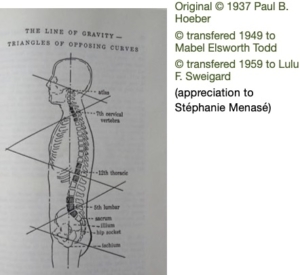
ø The seats of weight ~ Mabel Todd

"Tellington Touch Heart hug " ~ Origins
‘Intertwining Circles’ ©Katarina Halm August 2021
‘Intertwining Circles’ ©Katarina Halm August 2021
to develop as you may like~ meanwhile some notes here:
Imagine a clock in the area of your heart
~ and you can lightly trace with your fingertips or the palm of your hand.
1/
The first purpose is to connect with the heart area in a soft and gentle way
to honor the parasympathetic nervous system.
It can be a little tiny circle
~ we can go up to one shoulder all the way down to where our ribs end, a create a great big clock.
Or it can be a bigger circle.
~ a little tiny delicate clock, like a little locket or a small stone that we like to hold precious and close.
We trace one soft round of the clock or perhaps two rounds, easily, lightly.
~ when land down at six o’clock, pause there and just be aware of how we are breathing.
So there we are at six o’clock and we traced the whole round (or two) for a parasympathetic circle.
2/
Now an extra quarter of a circle for the sympathetic spark,
~ that spark of interest, curiosity, something new
~ in the same trajectory (same direction) of the circle we just completed.
We continue to go just a little more in the same direction.
~ a little puff of air can come in, inhale with the quarter of a circle
~ and then the exhaling out as we settle back down to six o’clock.
3/
Soon we will pause there to consider what have we done as we rest for a few easy breath cycles.
We traced a full soft circle in honor of the parasympathetic system.
We traced an extra quarter of a circle with a lively spark of air and back down to six in a salutation to the sympathetic system.
4/ We develop this each time a bit more. And now just a little bit at the beginning and end of our class today
As you move through your week you may find applications.
Perhaps practice at regular times such as when your clock reaches the top of each hour or half-hour.
~ Studies towards a vaccine
~ Resources for practical safety
~ Understanding current situations
ø Peter Kolchinsky March 2020 "#COVID19 most likely won’t be able to mutate to escape the vaccines we’re developing"
Noting from Peter Kolchinsky March 2020
Peter Kolchinsky Mar 24, 2020
Here’s something I once learned in virology school that should make you feel a bit better about why, unlike the flu, #COVID19 most likely won’t be able to mutate to escape the vaccines we’re developing. It has to do with the fact that COVID-19’s genome is made up of…
_____________________________
Replying to @PeterKolchinsky
Can you comment on the likelihood of a mutation and catching a different strain?
Peter Kolchinsky Mar 28, 2020
Link to this tweet:
https://twitter.com/PeterKolchinsky/status/1244126280053936129
talk of mutation is overblown. This comes up often. Flu mutates like a vine grows… coronaviruses mutate like a cactus grows. You can see a cactus grow if you look closely, but it’s still v. slow & our immune systems & vaccines will keep up easily… after this 1st bad exposure.
_____________________________
Link to the thread started by this tweet:
https://twitter.com/PeterKolchinsky/status/1244029896453754880
If you are hearing about #covid19 “reinfections” in Asia, I can offer you my take as a virologist. The best explanation for what we’re seeing is likely due to three things..
[A later tweet in this thread]
The main reason I’m skeptical that patients were actually reinfected so soon after recovering is due to what we know of the virus and recovery. Patients who beat their infection (and ~98-99% do), do so because their immune systems rev up enough to beat it.
[followed by]
And covid is barely mutating the parts that the immune system recognizes (the spike protein), so once a patient beats their high level of virus, they would easily be able to beat back whatever little virus they might get exposed to from others.
__________________________
[PK Answering this question: Could you respond to some question and fear of whether SARS-CoV-2 can behave like HSV and Herpes zoster virus becoming dormant inside the afflicted body cells and reactivate in some point in future]
Peter Kolchinsky Mar 29, 2020
Coronaviruses can’t lie dormant for long. Genomes are transient RNA (not sturdy DNA), & not being a retrovirus, they must replicate or die. They are like software that gets wiped when computer is shut off… they don’t reside on hard drives (like HIV, herpes, and hepatitis B do).
ø Derek Lowe’s articles on Coronavirus (updated August 18)
Encouraging News About Coronavirus Immunity – 18 August, 2020
A Close Look at the Frontrunning Coronavirus Vaccines As of May 1 (updated)
ø Prof. William Ristenpart of Chemical Engineering at UC Davis.~ CBC Radio Quirks & Quarks Monday April 13th, 2020
ø Neil Dunaetz comments on Zeynep Tufekci March 2020 "Tight coupling means that every part of the system moves together,"
Noting from Neil Dunaetz March 2020: “This recent article by Zeynep Tufekci at defenseone.com critiques the early response by the United States to the coronavirus pandemic in terms of the KIND OF THINKING that was–and was not–being applied.
https://www.defenseone.com/ideas/2020/03/it-wasnt-just-trump-who-got-it-wrong/164186/
Instead of thinking in terms of whole complex systems, it argues, we have made the reductionist error of treating abstract comparative terms as themselves real things, thus missing actual interactional complexity.
The sad result being that we failed to conceive what we were really up against. (And, imo, we continue to not grasp it well.)
Please notice especially, in the fourth paragraph from the end,
“…tight coupling between the components. Tight coupling means that every part of the system moves together, which in turn means that even small things can cause a crisis—for want of a nail.”
What the concept “tight coupling” tries to say is, imo, FUNCTIONALLY-CLOSE to what Gendlin means by “interaction first” and “sequences of whole events.”
By “functionally-close” I mean the two concepts are not equivalent as concepts. “Tight coupling” assumes individuated factors as prior and basic, and Gendlin’s model does not. But each of these very different ways of conceiving tries to speak from and about complex events in a way that strongly does not drop out emergent interactional complexity.”
ø Corona Virus resources, including Masks
Noting that Estrellita Gonzalez now has an online store for masks, several colours: https://www.myskinsalon.com/collections/face-mask “This will have both taxes added but should show free delivery within Vancouver but shipping charges apply outside of Vancouver (with free shipping on orders over $75 anywhere else)”. Many of you may know Estrellita from her work for the Vancouger School Board.
With appreciation to Sera Kirk: how to fold your own with a piece of cloth and two elastics. illustrated graphics at wikiHow instructions: https://www.wikihow.com/Make-a-%22No-Sew%22-Face-Mask
ø Dr. Jonah Sharma ~ how Covid-19 spreads and why wearing a mask helps prevent that spread
6-minute video featuring physician Dr. Jonah Sharma, who explains, in clear and simple terms, how Covid-19 spreads and why wearing a mask helps prevent that spread: https://www.youtube.com/watch?v=pesxqQkGBC4
ø By Peter S. Tippett, MD, PhD ~ Saving Your Health, One Mask at a Time
Dr Tippett: “I am an Internal Medicine-certified, Emergency Room MD with a PhD in Biochemistry. I have also spent much of my professional life in the high-tech world helping people understand how risk, infection, and the growth of infection behaves. So I thought it might be helpful to folks in my network to explain how personal protection from a virus like SARS-CoV-2 (the formal name of the virus that causes COVID-19) actually works, how any given measure individually lowers risk, how various countermeasures work together, and most importantly, to give you some simple guidelines for day-to-day living in this new COVID world. ”
https://caremesh.com/blog/2020/4/8/saving-your-health-one-mask-at-a-time
ø Article on respiratory viruses
ø Serge Prengel with Stephen Porges Dealing with social distancing
9-minute video conversation Serge Prengel with Stephen Porges, developer of the Polyvagal Theory, about countering the effects of social distancing: https://relationalimplicit.com/porges-social/
Also on YouTube: https://www.youtube.com/watch?v=6FGTHm6R4pc&list=PLT6ApC3q1w9GMlCWMdu3qSGapSjd-6kxx
Stephen Porges: Dealing with social distancing Relational Implicit March 2020 Stephen W. Porges, Ph.D., is Distinguished University Scientist at Indiana University, where he directs the Trauma Research Center within the Kinsey Institute. He holds the position of Professor of Psychiatry at the University of North Carolina and Professor Emeritus at the University of Illinois at Chicago and the University of Maryland. He served as president of both the Society for Psychophysiological Research and the Federation of Associations in Behavioral & Brain Sciences and is a former recipient of a National Institute of Mental Health Research Scientist Development Award. He has published more than 250 peer-reviewed scientific papers across several disciplines including anesthesiology, critical care medicine, ergonomics, exercise physiology, gerontology, neurology, obstetrics, pediatrics, psychiatry, psychology, space medicine, and substance abuse. In 1994 he proposed the Polyvagal Theory, a theory that links the evolution of the mammalian autonomic nervous system to social behavior and emphasizes the importance of physiological state in the expression of behavioral problems and psychiatric disorders.
Serge Prengel, LMHC is the editor the Relational Implicit project (http://relationalimplicit.com).
Social distancing and separation are a big part of what is needed to deal with the pandemic. In this short conversation, we talk about how to counter their effects: we still need to be sensitive to our nervous system’s need to socially engage and connect.
Serge Prengel (00:00): These are really difficult times.
Stephen Porges (00:03): They certainly are. And there’s an irony going on because we have to avoid becoming infected. There’s no question that the Coronavirus is a health risk, especially to those of us who are more mature. It is real. The question is related to the way that we need to behave to reduce that risk through social isolation. And this strategy creates an amazing PARADOX for our nervous system and our needs to interact with other people because, as humans we have a powerful need is to connect and to CO-REGULATE with others, but now we’re being told that this is not the right thing to do. There are priorities and the top priority is not to get infected, but there’s also a priority of understanding the needs of our nervous system…
Serge Prengel (00:51): So, this is a counterintuitive situation where we cannot trust our instinct, evolutionary instinct, because we have to do something different. Not from coercion, but actually from understanding that social isolation is required at this point.
Page 2
Stephen Porges (01:08): I think that is a really concise way of explaining the PARADOX through which our nervous system is trying to navigate. And that is, we need to socially isolate. However, our nervous system says, Hey, that’s not the way we evolved, not the way we need to be. We need to co-regulate, so we need to be smart.
(01:31): Now we need to know what the TRUE PRIORITIES are. And the top priority of course, is to stay alive. But how can we mitigate that nervous system’s demand, request, and passion, to connect? And we have to find ways to connect! We have to do that through telephone and through video chat. They are really reasonably good, and email is okay, but the value of hearing someone’s voice or seeing someone’s face is a powerful reassuring cue of safety to our nervous system. So we have to reach out. It’s been remarkable over the past few days, because the world turned from a social to an isolated world within in a week.
(02:09): A week ago, I was in New York city, it was elbow to elbow. I was talking at a crowded conference. And my comment was, I’ll give people hugs. I’ll shake their hands this month, but next month I will do something different. And within a few days, the world changed. And we realized that it wasn’t a fear of a virus that was really distal in time. It was here. We need to really take care of ourselves and to really MONITOR our bodies’ need to connect, to give others a hug, to smile, to be reassuring, to touch them on their shoulders or on their hands, to let them know that we’re here to support them and be with them. What I’ve noticed over the past few days is my very close friends have reached out through video conferencing, through phone calls, just to connect. It’s really a beautiful moment when people are reaching out to say, I’M HERE. HOW ARE YOU? What can I do for you?
Serge Prengel (03:14): Yeah. So, we don’t kill that impulse to connect . We channel it, and savor it as we find ways to do it through voice and sight – – phone and videoconferencing.
Stephen Porges (03:34): Yes. We MODIFY because we are a relatively intelligent species (at times we are not so sure about that). We are reading our bodily feelings. And our bodily feelings want to be held, want to be embraced, want to be safe with the people whom we trust. That’s basically a neural circuit that’s reaching out. We’re really saying to that neural circuit: We can’t do that now.
(03:59): If we don’t ENGAGE people for a period of time, we go into another state. That is, we become marginalized and we start to become too isolated. And this is really very, very bad for our nervous system. And our body will react to that with a bias of negativity. This is the other issue. As we separate, the notions of being overly concerned, or neurotic, or paranoid about the situation will increase because we are not getting sufficient OPPORTUNITIES to CO-REGULATE.
(04:32): So, being smart, we need to reach out and use the tools that we have. The internet is a useful tool. Through videoconferencing, we can talk, we can hear each other’s voices and we can feel connected. Again, it’s not equivalent to being in the room with a person, but it’s a lot better than not having any contact.
Serge Prengel (04:54): 3 Then, when we connect, when we communicate this way, there is an intentionality that the communication is not just about the content. The communication is about co-regulating. It Is about that sense of connection that we crave.
Stephen Porges (05:15): Absolutely. Because it’s not the words, it’s the intentionality of feelings that we’re communicating with each other. We’re creating a capacity CO-REGULATE each other’s physiological and emotional and behavioral state. As we CO-REGULATE each other, we feel SAGER in the SPACE and TIME that we’re in. We become more generous to others, more welcoming and more accessible.
(05:41): As we isolate, the separated bodies and nervous systems, become more defensive. The nervous system literally supports these feelings of isolation and defensiveness. So we have to be smart. We have to retailor or reframe what isolation is. In this situation. It’s a defense, but we don’t want it to blend or bleed into becoming defensive of our interactions with others. And so we need to really reach out and use the tools that are available to us and ENGAGE others. Use our voices, use our facial expressions, with VIDEO chatting.
(06:22): It’s a lot better than texting. The issue of texting and email is that you’re stripping the voice and the face from the words. Our nervous systems evolved to detect the intonation. I’s only through long a long period of evolution that our nervous system was able to create language, to create SYNTAX and to extract MEANING from SYMBOLS. So we want to relate to each other on a very… almost a primitive level. And that is facial expressivity and intonation of voice. We have the telephone for the voice and we have video chatting for voice and facial expressions.
Serge Prengel (07:01): And so, maybe, we can even go one step further than simply chatting on the phone or videoconferencing. As we are in communication, we consciously pay attention to what’s happening in our body. And communicate with each other that what we’re doing is not just exchanging content, exchanging news, but the PROCESS of co-regulating itself. For instance, as we talk, I am feeling my energy coming down a bit. I’m feeling more SETTLING, a sense of SETTLING and GROUNDING…
Stephen Porges (07:44): You’re feeling connectedness. And what you’re really emphasizing is that it’s not a show-and-tell. It’s a co-regulation. And we have terms that we use: mirroring, attuning, or synchrony. But really it’s all about co-regulating. And what you were emphasizing was to acknowledge one’s own feelings. I would go a step further. That is, to MONITOR and acknowledge the feelings of the one that you’re talking to. So you’re reaching literally into their sphere, their consciousness, their nervous system. And you’re really saying: I’m present. I’m here with you.
Serge Prengel (08:23): Yeah. So that’s a very good step. We’re talking about reaching out. Reaching in and reaching out. Reaching inside, reaching out to the other person. MONITORING myself, MONITORING each other. Having a sense of this is what connection is about. This is what we’re experiencing as we’re connecting. Stephen Porges (08:44): Yes. I think that’s a very good summary of the message.
Serge Prengel (08:49): 4 Thanks, Steve.
Stephen Porges (08:50): Oh, you’re quite welcome. Serge. It’s good to connect during this time with you. Thank you.
© 2020. All rights reserved. Relational Implicit and its web address (relationalimplicit.com) should be properly cited when these contents are used in any form.
ø Stephen Porges "The Polyvagal Theory"~ references and YouTube clips
Stephen Porges books
https://www.amazon.ca/s/?ie=UTF8&keywords=stephen+…
Stephen Porges “The Polyvagal Theory” YouTube
https://www.youtube.com/watch?v=8tz146HQotY
https://www.youtube.com/watch?v=ivLEAlhBHPM
https://www.youtube.com/watch?v=yVVaTRbegJs
https://www.youtube.com/watch?v=8RKC3Ga6shs
https://www.youtube.com/watch?v=kntgKn54jX4
Dr. Stephen Porges – Human Nature and Early Experience
https://www.youtube.com/watch?v=SRTkkYjQ_HU
Oct 24, 2014 … The Early Development of the Autonomic Nervous System Provides a Neural Platform for Social Behavior: A Polyvagal Perspective Credit: ACEatND Human Nature an… 34: The Science of Safety with Stephen Porges
https://www.youtube.com/watch?v=na2blnkRhAY
ø Porges, S. W. (2020). The COVID-19 Pandemic is a paradoxical challenge to our nervous system, a Polyvagal Perspective. Clinical Neuropsychiatry, 17(2),135-138./ list of section titles and quotes
Porges, S. W. (2020). The COVID-19 Pandemic is a paradoxical challenge to our nervous system, a Polyvagal Perspective. Clinical Neuropsychiatry, 17(2),135-138./ list of section titles and quotes
Below is a List of Section titles and Track names of an informal reading of the article:
Porges, S. W. (2020). The COVID-19 Pandemic is a paradoxical challenge to our nervous system, a Polyvagal Perspective. Clinical Neuropsychiatry, 17(2),135-138.
with appreciation to Jenn Wesanko for sending us the article.
1/Abstract and credits. page 135
2/ The Pandemic impacts on our biological
imperative to connect. page 135
3/A one nervous system model heightens
awareness of bidirectional brain-body
communication . page 135
4/A Polyvagal Perspective. page 136
5/Public health strategies compound feelings of
threat. page 136
6/ Mitigating threat responses through
videoconferencing page 137
7/ Conceptualizing autonomic state as an intervening
variable enhances the understanding of
risk and optimizes treatment page 137
8/ References pages 137-8
* Cabrera, A., Kolacz, J., Pailhez, G., Bulbena‐Cabre, A.,
* Bulbena, A., & Porges, S. W. (2018). Assessing body
awareness and autonomic reactivity: Factor structure
and psychometric properties of the Body Perception
* Questionnaire‐Short Form (BPQ‐SF). International
journal of methods in psychiatric research, 27(2), e1596.
* Dobzhansky, T. (1962). Mankind evolving (pp. 150-152).
New Haven: Yale University Press.
* Dobzhansky, T. (1973). Nothing in biology makes sense
except in the light of evolution. The american biology
teacher, 35(3), 125-129.
* Hess, W. R. (1949). Nobel lecture. Nobel Lectures, Physiology
or Medicine (1942-1962).
* Jackson, J. H. (1884). The Croonian lectures on evolution
and dissolution of the nervous system. British medical
journal, 1(1215), 703.
* Kolacz J., Dale L., Nix E., Lewis G. F., & Porges S. W.
(unpublished). Trauma history predicts self-reported
autonomic reactivity and psychological wellbeing during
the COVID-19 pandemic.
* Porges, S. (1993). Body perception questionnaire. Laboratory
of Developmental Assessment, University of Maryland.
* Porges, S. W. (1995). Orienting in a defensive world:
Mammalian modifications of our evolutionary heritage. A
polyvagal theory. Psychophysiology, 32(4), 301-318.
* Porges, S. W. (2003). Social engagement and attachment:
a phylogenetic perspective. Annals of the New York
Academy of Sciences, 1008(1), 31-47.
* Porges, S. W. (2004). Neuroception: A subconscious system
for detecting threats and safety. Zero to Three (J), 24(5),
19-24.
* Porges, S. W. (2007). The polyvagal perspective. Biological
psychology, 74(2), 116-143.
* Porges, S. W. (2009). The polyvagal theory: new insights
into adaptive reactions of the autonomic nervous system.
Cleveland Clinic journal of medicine, 76(Suppl 2), S86.
Rick Hansen podcast with Dr Stephen Porges
Rick Hansen (author of ‘Take in the Good’ and ‘Buddha Brain’.) podcast with Dr Stephen Porges
~ learning new ways to adapt to stress in these times
~ the ways we need to adapt to remain safe challenge how we have evolved.
https://www.rickhanson.net/being-well-podcast-polyvagal-theory-with-stephen-porges/
Dr. Stephen Porges, ~ the Safe and Sound Protocol (SSP)
Video ~ Ask Me Anything (AMA) with Stephen Porges - February 3, 2022
ø Graphics: Jan Winhall Felt Sense Polyvagal Model of Emotional Regulation
Please click for a PDF file to view, print, or download
Jan Winhall’s charts Felt Sense Polyvagal Model of Emotional Regulation
Client version 2022 ~ 2022_Client_6Fs_p3 Jan Winhall © 2022 PDF
ø The Felt Sense/Polyvagal Model by Jan Winhall
The Felt Sense/Polyvagal Model by Jan Winhall
… notes from Jan Winhall:
Felt Sense Experience Model of Emotional Regulation (Webinar)
by Jan Winhall https://www.focusingonborden.com/model
“In a series presented by The International Focusing Institute, this two-hour workshop (presented by Jan Winhall), explores how stress and traumatic experience prevents and/ or disrupt our capacity to be grounded. Jan presents material from her chapter in Emerging Practice In Focusing-Oriented Psychotherapy and guides viewers through various experiential exercises.
If you would like access to this webinar, we ask you to make a small donation to The International Focusing Institute [https://focusing.org/civicrm/contribute/transact?reset=1…]. Please specify this donation for “Jan Winhalls Webinar,” and a password will be sent to you by email. ”
Jan Winhall MSW RSW
www.focusingonborden.com
Adjunct Lecturer
Faculty of Social Work
University of Toronto
ø Jan Winhall Article: Addiction from the Bottom Up: A Felt Sense Polyvagal Model of Addiction
ø The 6 Steps of the PolyVagal Dialogue (FSPD) © 2021 by Jan Winhall
Please click for a PDF file to view, print, or download
The 6 Steps of the PolyVagal Dialogue (FSPD)
6_Steps_FSPD Copyright © 2021 by Jan Winhall MSW, RSW, FOT. www.janwinhall.com
ø FSPM Two Body Processes Interception & Neuroception ©2022 JanWinhall.com
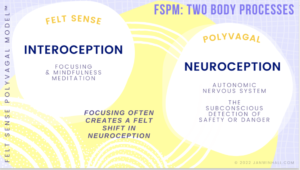
ø 5 Lessons of PolyVagal Theory ©2022 JanWinhall.com Notes: ‘Polyvagal Theory in Practice’ Canadian Region P2P May 28, 2023
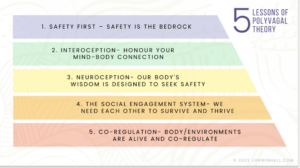 5 Lessons of PolyVagal Theory ©2022 JanWinhall.com Notes: ‘Polyvagal Theory in Practice’ Canadian Region P2P May 28, 2023
5 Lessons of PolyVagal Theory ©2022 JanWinhall.com Notes: ‘Polyvagal Theory in Practice’ Canadian Region P2P May 28, 2023
ø The Intervening Variable ©2022 JanWinhall.com
ø The Felt Sense PolyVagal Model™ Client Version 6 F’s (3:3) ©2022 JanWinhall.com
Diagrams showing the various branches
of the Vagus Nerve
and the organs involved
ø General layout of the Vagus Nerve
This diagram is from a website that specializes in acupuncture: “https://www.morningsideacupuncturenyc.com/blog/acupuncture-and-the-vagus-nerve”
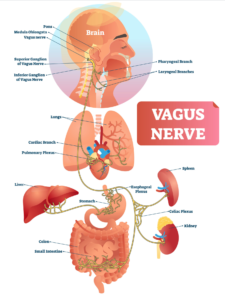
ø The focus is the nervous system
This diagram is from a website that specializes in functional medical problems that are influenced by the nervous system, especially GI problems:
donthateyourguts.com/turn-on-your-vagus-nerve-with-pleasure
The focus is the nervous system, not psychological problems
In my experience, the kind of psychotherapy that is most effective and efficient for helping people with functional medical problems is focused on regulating the nervous system. In contrast, traditional psychotherapy is focused on addressing emotional, behavioral, and relationship problems.
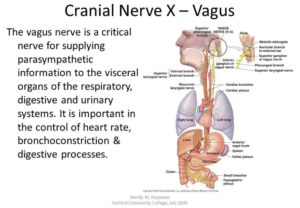
ø Anatomical drawings - Vagus
Anatomical drawings – Vagus
Origins of the Vagus nerve
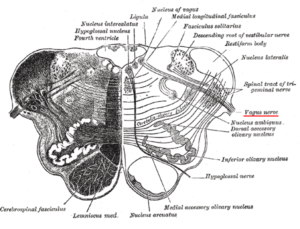
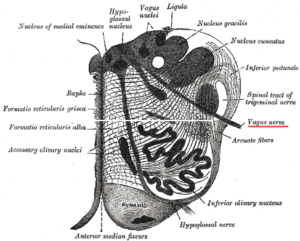
ø Anatomical discussion - length of the trachea in the neck with extension
“In the ADULT, the trachea SITS ANTERIORLY in the neck and DIVES POSTERIORLY in the mediastinum as it travels toward the carina. This ANGLE of DESCENT is more acute in children and tends to become more horizontal with age due to kyphotic changes in the spine and tethering of the LEFT mainstem BRONCHUS under the AORTIC ARCH.” (emphasis added)
” in ELDERLY patients, the LENGTH of the trachea in the neck tends to remain CONSTANT with CERVICAL EXTENSION, this contrasts with YOUNGER patients for whom it TENDS to LENGTHEN.” (emphasis added)
“ELDERLY patients tend NOT to increase the length of the trachea in the neck with CERVICAL EXTENSION, as do younger patients.” (emphasis added)
“‘the fittest may also be the gentlest, because
survival often requires mutual help and cooperation’
(Dobzhansky, 1962). According to Dobzhansky, it
is this capacity to cooperate that enabled the earliest
mammalian species to survive in a hostile world
dominated by physically larger and potentially
aggressive reptiles. Although unaware of Dobzhansky’s
major contributions, the publication that introduced
Polyvagal Theory was titled “Orienting in a defensive
world: Mammalian modifications of our evolutionary
heritage. A Polyvagal Theory” (Porges, 1995). In
retrospect, the title was a tribute to Dobzhansky’s
insightful statement that “nothing in biology makes
sense except in the light of evolution” (Dobzhansky,
1973).”
–– Stephen W. Porges, page 135 in Porges, S. W. (2020). The COVID-19 Pandemic is a paradoxical challenge to our nervous system, a Polyvagal Perspective. Clinical Neuropsychiatry, 17(2),135-138.
~~~~~~~~~~~~~~~~~
Below is a List of Tracks for an informal reading of the article:
Porges, S. W. (2020). The COVID-19 Pandemic is a paradoxical challenge to our nervous system, a Polyvagal Perspective. Clinical Neuropsychiatry, 17(2),135-138.
with appreciation to Jenn Wesanko for sending us the article.
1/Abstract and credits. page 135
2/ The Pandemic impacts on our biological
imperative to connect. page 135
3/A one nervous system model heightens
awareness of bidirectional brain-body
communication . page 135
4/A Polyvagal Perspective. page 136
5/Public health strategies compound feelings of
threat. page 136
6/ Mitigating threat responses through
videoconferencing page 137
7/ Conceptualizing autonomic state as an intervening
variable enhances the understanding of
risk and optimizes treatment page 137
8/ References pages 137-8
Cabrera, A., Kolacz, J., Pailhez, G., Bulbena‐Cabre, A.,
Bulbena, A., & Porges, S. W. (2018). Assessing body
awareness and autonomic reactivity: Factor structure
and psychometric properties of the Body Perception
Questionnaire‐Short Form (BPQ‐SF). International
journal of methods in psychiatric research, 27(2), e1596.
Dobzhansky, T. (1962). Mankind evolving (pp. 150-152).
New Haven: Yale University Press.
Dobzhansky, T. (1973). Nothing in biology makes sense
except in the light of evolution. The american biology
teacher, 35(3), 125-129.
Hess, W. R. (1949). Nobel lecture. Nobel Lectures, Physiology
or Medicine (1942-1962).
Jackson, J. H. (1884). The Croonian lectures on evolution
and dissolution of the nervous system. British medical
journal, 1(1215), 703.
Kolacz J., Dale L., Nix E., Lewis G. F., & Porges S. W.
(unpublished). Trauma history predicts self-reported
autonomic reactivity and psychological wellbeing during
the COVID-19 pandemic.
Porges, S. (1993). Body perception questionnaire. Laboratory
of Developmental Assessment, University of Maryland.
Porges, S. W. (1995). Orienting in a defensive world:
Mammalian modifications of our evolutionary heritage. A
polyvagal theory. Psychophysiology, 32(4), 301-318.
Porges, S. W. (2003). Social engagement and attachment:
a phylogenetic perspective. Annals of the New York
Academy of Sciences, 1008(1), 31-47.
Porges, S. W. (2004). Neuroception: A subconscious system
for detecting threats and safety. Zero to Three (J), 24(5),
19-24.
Porges, S. W. (2007). The polyvagal perspective. Biological
psychology, 74(2), 116-143.
Porges, S. W. (2009). The polyvagal theory: new insights
into adaptive reactions of the autonomic nervous system.
Cleveland Clinic journal of medicine, 76(Suppl 2), S86.
“you can also increase the flow of oxygen to your lungs by not resting on your back” with appreciation to Doug Bolston for sending us the excerpt from https://www.nytimes.com/2020/04/30/well/live/coronavirus-days-5-through-10.html
[excerpt]:
While every patient is different, doctors say that days five through 10 of the illness are often the most worrisome time for respiratory complications of Covid-19, particularly for older patients and those with underlying conditions like high blood pressure, obesity or diabetes. Younger patients who develop complications may begin struggling a little later, as late as days 10 to 12. Most people who reach day 14 without any worrying symptoms (other than feeling miserable and fatigued) are likely to be on the road to recovery.
The best way to monitor your health during this time is to use a pulse oximeter, a small device that clips on your finger and measures your blood oxygen levels. (There are phone-based apps meant to do this, but they have tested poorly) The normal oxygen saturation range is about 96 to 99 percent. If your blood oxygen reading drops to 92 percent, it’s time to call a doctor.
While at home, you can also increase the flow of oxygen to your lungs by not resting on your back. Resting on your stomach, in the prone position, can open parts of the lungs that are compressed when lying on your back. You can also change to resting on your left side or right side, or sit upright in a chair.
James Nestor interview (May 27th, 2020)
with Fresh Air’s Terry Gross (shorter, and audio only):
<https://www.npr.org/sections/health-shots/2020/05/27/862963172/how-the-lost-art-of-breathing-can-impact-sleep-and-resilience>
Link also includes a transcript of some of the highlights
Noting the website of Deb Dana
http://www.rhythmofregulation.com/Polyvagal-Resources.php
……………………………………………
notes below thinking along the way … some definitions … to be consolidated
~~ VENTRAL / DORSAL in relation to PolyVagal ~~
(ventral and dorsal refer to where the vagus nerve originates in the brain stem)
~~ there was talk about three [branches] of the Vagus nerve ~~
PolyVagal [referring to parasympathetic branches of the autonomic Nervous System]
Branches of the Vagus nerve are Postulated as follows …
1/ a Uniquely MAMMALIAN branch of the vagus
~ conveys a respiratory rhythm to the heart’s pacemaker,
resulting in rhythmic oscillation in heart rate
at the frequency of spontaneous breathing
known as RESPIRATORY SINUS ARRHYTHMIA
~ uniquely mammalian pathway
~ myelinated
~ ORIGINATES in an area of the brain stem
known as the NUCLEUS AMBIGUUS
~ TRAVELS PRIMARILY to organs above the diaphragm
~ interacts within the brain stem with structures
regulating the striated muscles of the face and head.
2/ [REPTITILAN & MAMMALIAN branch of the vagus ]
An originally primitive vagal motor pathway
~ does not have a respiratory rhythm
~ observed in virtually all vertebrates
~ unmyelinated
~ ORIGINATES in an area of the brain stem
known as the DORSAL NUCLEUS of the VAGUS.
~ TRAVELS PRIMARILY to organs below the diaphragm
3/ [ a third branch or plexus or …. of the vagus ]
[~ associated with the Trigeminal nerve…]
……………………………………………
“Vagal tone refers to activity of the vagus nerve,
the 10th cranial nerve and a fundamental component
of the parasympathetic branch of the autonomic nervous system.
This branch of the nervous system is not under conscious control
and is largely responsible for the regulation of several body compartments at rest”
https://en.wikipedia.org/wiki/Vagal_tone
……………………………………………
“Respiratory Sinus Arrhythmia
RSA refers to the naturally occurring variability in the length of time between heart beats that is coordinated with the respiratory cycle, and often used as an index of parasympathetic control of heart rate.
From: Reference Module in Neuroscience and Biobehavioral Psychology, 2017”
FROM https://www.sciencedirect.com/topics/medicine-and-dentistry/respiratory-sinus-arrhythmia
……………………………………………
“Respiratory sinus arrhythmia (RSA)
is heart rate variability in synchrony with respiration,
by which the R-R interval on an ECG 3WE M8,9.
is shortened during inspiration and prolonged during expiration.”
Review Chest
. 2004 Feb;125(2):683-90. doi: 10.1378/chest.125.2.683.
Respiratory sinus arrhythmia: why does the heartbeat synchronize with respiratory rhythm?
FROM https://pubmed.ncbi.nlm.nih.gov/14769752/
* https://www.youtube.com/watch?v=hx3U64IXFOY
Using Failures, Movement & Balance to Learn Faster | Andrew Huberman Lab Podcast #7 “In this episode, I discuss how we can use specific types of behavior to change our brain, both for sake of learning the movements themselves and for allowing us to learn non-movement-based information as well. I describe the key role that errors play in triggering our brains to change and how the vestibular (balance) system can activate and amplify neuroplasticity. As always, I cover science, and science-based practical tools. Thank you in advance for your questions and for your interest in science! ”
* Huberman episode: The Science of Emotions & Relationship – Episode 13. speaking about the vagus nerve towards the end
https://podcasts.apple.com/ca/podcast/the-science-of-emotions-relationships-episode-13/id1545953110?i=1000514835897 including “Mirror Neurons: Are Not For “Empathy”, Maybe For Predicting Behavior”
* Noting also Larry G – Online Summer Camp: https://mindinmotion-online.com/summer-camp-2021/
The FGNA (Feldenkrais Guild® of North America) disclaimer states that anyone who is unauthorized to practice Functional Integration® lessons, Awareness Through Movement® lessons, or the Feldenkrais Method® of somatic education, or use FGNA service marks unless they have received authorization from FGNA.
* Attendees who are not authorized to use FGNA service marks are required to sign a form that has been approved by FGNA
* More details at https://www.feldenkraisguild.com/teach-applications-events
* Here is a direct link to the form https://www.feldenkraisguild.com/Files/attendee_agreement_form.pdf
Posted by FGNA June 2021.
The following are service marks, trademarks, collective, or certification marks of the Feldenkrais Guild® of North America in the US: Feldenkrais Guild®, Feldenkrais®, Feldenkrais Method®, Functional Integration®, FI®, Awareness Through Movement®, ATM®, Guild Certified Feldenkrais Teacher®, GCFTCM, Guild Certified Feldenkrais PractitionerCM, GCFPCM, Certified Feldenkrais Awareness Through Movement TeacherCM, CFATMTCM, Feldenkrais JournalTM, Friends of FeldenkraisSM, and FGNA Feldenkrais Method Logo.
The following are service marks, trademarks, or certification marks of the Feldenkrais Guild® of North America in Canada: Feldenkrais GuildTM, Feldenkrais®, Feldenkrais® Method or Feldenkrais MethodTM, Awareness Through Movement®, ATMTM, Prise de conscience par le mouvementMD, Functional Integration®, FITM, L’intégration fonctionnelleMD, Guild Certified Feldenkrais TeacherTM , GCFTTM, Guild Certified Feldenkrais PractitionerTM, GCFPTM, Certified Feldenkrais Awareness Through Movement TeacherTM, CFATMTTM, Friends of FeldenkraisSM , Feldenkrais JournalTM, and FGNA Feldenkrais Method Logo.